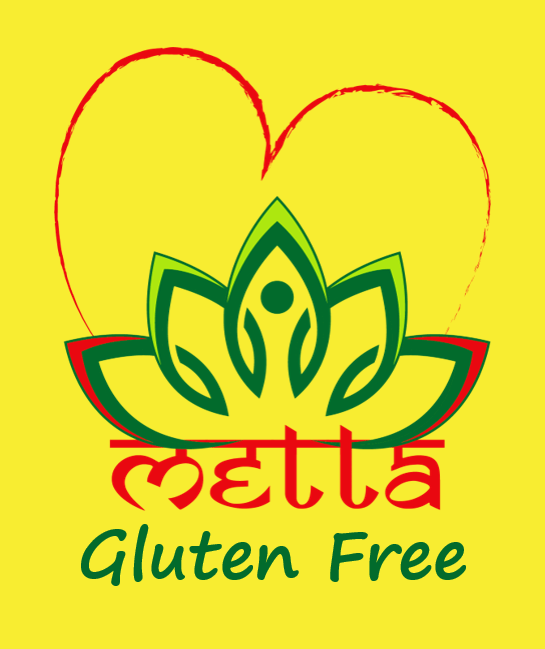Frequently Asked Questions
If you have any other questions not addressed here, please write to us and we will respond promptly.
What should I do if Metta flour is near it's "best by" date or is past it's "best by" date?
If stored properly, Metta Gluten Free flour is safe to use past its “best by” date. It is recommended that you store Metta Gluten Free flour in an airtight container in an air-conditioned, cool environment with temperatures between 65 to 75 Fahrenheit. If the flour is past its best by date, it will still be fine for 6 – 12 months if unopened as long as it is kept at room temperature. We have tested the flour in our facility this way by storing it unopened at room temperature and were successfully able to use the flour even after a year past its best by date. Once opened, to be on the safe side, store it in an airtight container in the refrigerator and use it within a month. Bottom line, if the flour looks fine meaning no discoloration, smells fine, and tastes fine, then it should be fine to use even if it is past its best by date.
How can I be sure Metta flour is 100% gluten-free?
Metta Gluten Free flour is manufactured and packaged in a certified gluten-free and non-GMO facility in the United States of America. Metta flour has been tested to ensure it meets the FDA gluten-free standard of less than 20ppm (parts per million) of gluten. In fact, gliadin results testing on Metta Gluten Free flour indicated that it has less than 5 ppm of expressed gluten. If you would like to obtain these results, let us know and we would happy to email those results to you for your peace of mind. We are planning to seek the gluten free certification in the near future!
What is Metta Gluten Free flour?
Metta Gluten Free flour is blend of healthy gluten free flours and non-GMO ingredients (sweet brown rice flour, sorghum, tapioca, teff, arrowroot, potato, ground flaxseed, and xanthan gum). An allergen-friendly flour that is free of top 14 allergens. It is a unique flour in that it makes soft and flavorful flatbreads like tortillas and Indian chapatis that taste and feel similar to the traditional whole wheat flatbreads. In addition, it also makes delicious baked goods like cookies, muffins, breads, cakes, pizza crust, and so much more. The possibilities are endless and you won’t miss the gluten!
What does atta mean?
In the Indian language of Hindi, atta refers to whole wheat flour. However, colloquially it refers to any flour used to make Indian flatbreads, like chapatis (or rotis), parathas (stuffed flatbreads), and puris (fried breads). The chapatis made from Metta flour can be used as tortillas, wraps, and soft tacos.
Is Metta flour a 1:1 flour?
No, it is not. While we have many customers who have reported successfully using Metta flour as a 1 to 1 replacement in recipes, Metta flour was not developed as an all purpose baking flour. Metta flour does still produce great tasting baked goods but may require adjustments. Since the Metta flour blend was developed to create a similar texture and taste to whole wheat flour, goods baked with Metta flour may be more dense and moist, especially when made without eggs.
To help our loyal customers, all the recipes presented on our website have been tested and modified to create baked goods that are as fluffy and light as their gluten-full counterparts.
Check out our ever growing Recipe list.
What is the best way to store Metta flour?
It is recommended that you store Metta flour in an airtight container in an air-conditioned, cool environment with temperatures between 65 to 75. If the flour is past its best by date, it will still be fine for 6 months to a year if unopened as long as it is kept at room temperature. If opened, to be on the safe side, store it in an airtight container in the refrigerator.
What should I do if the dough is hard and the flatbread is stiff and dry?
If the dough is hard, it probably needs a little more water to soften it. Add water a little at a time because you don’t want it to get sticky. Also, one of tricks to making to a soft flatbread is a well kneaded dough so make sure you have kneaded the dough for at least 5-7 minutes.
Can I store the flour in a freezer or a refrigerator?
Yes, you can. It will last the longest this way, particularly if opened and you intend on keeping it for several months.
Will the flatbreads with Metta flour be exactly like the wheat based chapatis and tortillas?
When cooking and baking with gluten-free flours, manage your expectations. It will never be exactly like the wheat based flatbreads, but once you get accustomed to using this flour to make flatbreads, they will come very close to the wheat like look and texture. Have patience with yourself and keep practicing making the flatbreads. For further tips, watch these videos on our Metta Flour YouTube Channel
What should I do if the dough is too sticky and breaks when rolling?
Add a little dry flour and knead the dough. Keep adding a little dry flour and kneading until the dough is smooth and pliable.
What is xanthan gum in Metta flour derived from?
Xanthan gum is derived from a bacteria (Xanthomonas campestris), that’s fed a sugar derived from corn, soy, sugar cane, beets, or wheat. From there, gum is refined and purified, which removes any grain by-products. For this reason, the FDA states that the source of the xanthan gum does not need to be declared on the label even if the source is from an allergen. Xanthan gum in Metta flour is sourced from non-GMO corn from Austria, which has shown not to have any traces of corn grain. However, if you feel that you may still have a reaction to the xanthan gum grown on sugar derived from corn, we recommend that you use your judgement and take caution when using Metta flour. Having said that, we have customers with allergies to corn and have not reported any adverse reactions to Metta flour.
Will Metta Gluten-Free flour work in any automatic tortilla or roti machines?
Yes, we have several customers reporting that Metta flour works in the Rotimatic making fresh chapatis. The settings our customers have used in the Rotimatic are for Aashirvaad and Chakka Fresh flours. It also works in the Brentwood Roti & Tortilla Maker. For the Brentwood like presses, the prepared dough requires more water (about 70% quantity of the flour, between ⅔ – ¾ cup of water in 1 cup flour) yielding a more sticky and gooey dough so it can be pressed with greater ease to thin out to make tortillas and chapatis.








